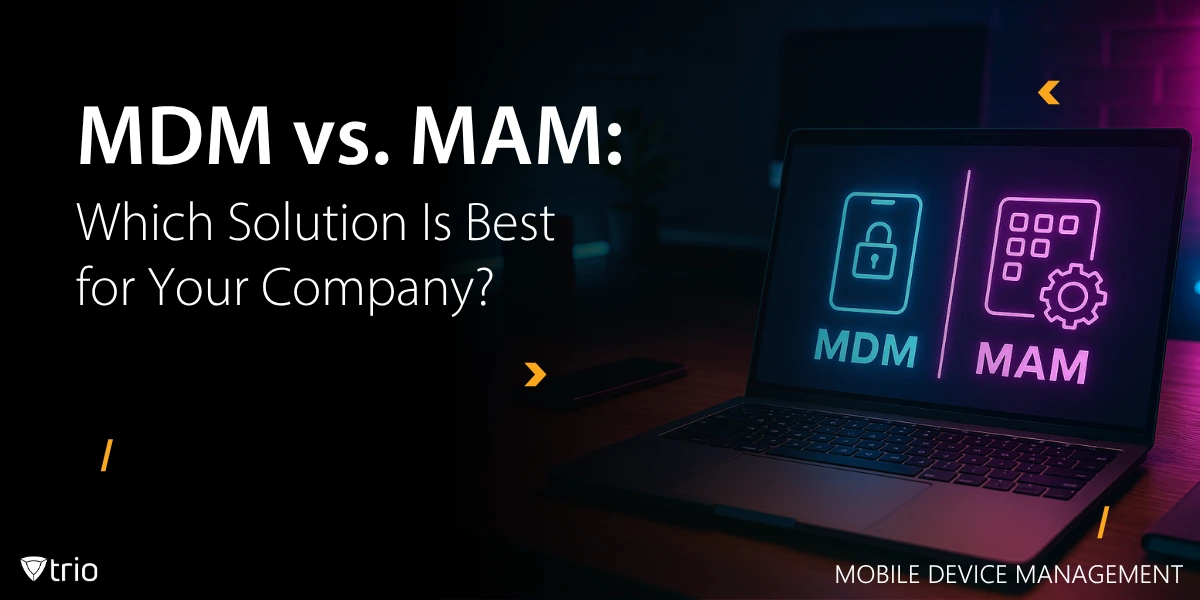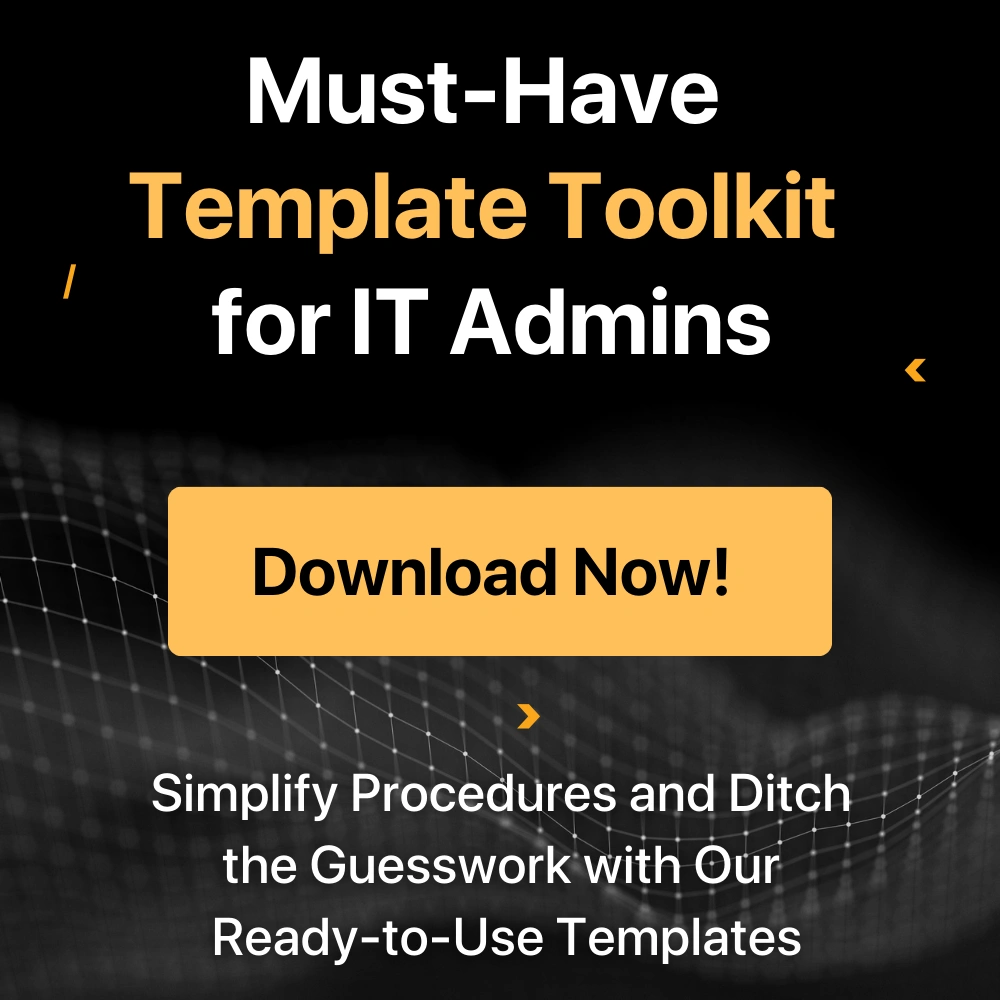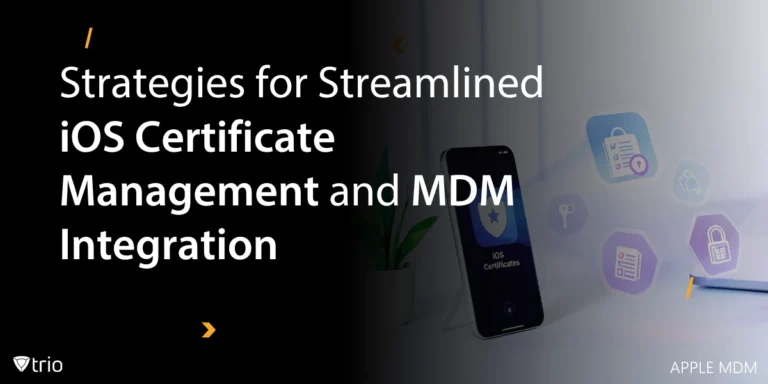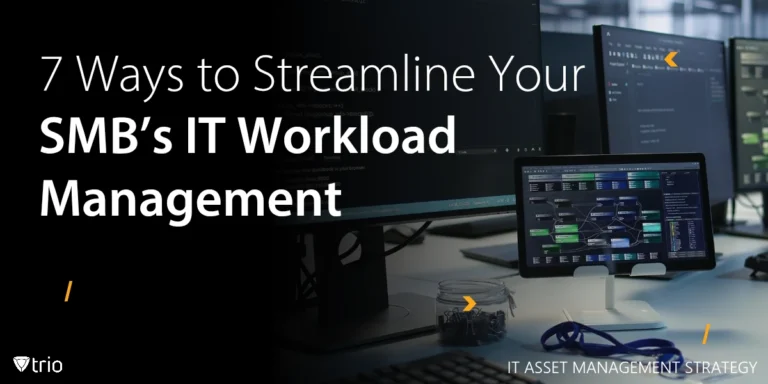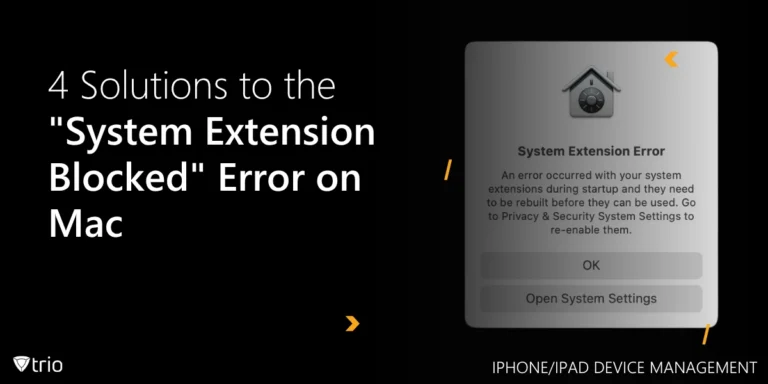A single lost device can expose thousands of sensitive files, unless you can wipe it remotely. As teams work from anywhere, using a mix of corporate and personal devices, IT admins face a critical challenge: How do you protect data without locking down every phone, tablet, or laptop in sight?
If you’re managing mobile access to company systems, the question often comes down to MDM vs. MAM.
| Mobile Device Management (MDM) | Mobile Application Management (MAM) | |
|---|---|---|
| What it manages | The entire device (company- or employee-owned) | Only corporate apps and data |
| Best for | Company-owned or mixed environments | BYOD (Bring Your Own Device) |
| Control level | Full (hardware, OS settings, apps, and network) | Granular (app-level policies and data isolation) |
| Data protection scope | Whole device; supports remote wipe | Corporate data only; app-level wipe options |
What You’ll Learn in This Guide:
- Clear definitions of MDM and MAM
- Real-world data types these tools protect (e.g., emails, internal files, client records, HR apps)
- Common use cases and implementation pain points
- A comparison table to help you choose what fits your environment
- How lean platforms like Trio simplify both approaches for SMBs
What Is Mobile Device Management (MDM)?
If you're issuing devices to employees or letting them use personal phones for work, you need a way to secure corporate data and reduce IT friction. Mobile Device Management (MDM) gives you exactly that: control, visibility, and policy enforcement over your device fleet.
Whether it's laptops for remote staff or iPhones in the field, MDM ensures that the devices accessing your systems stay compliant, secure, and manageable.
Why MDM Still Matters in 2025
| What It Solves | MDM Capability | Example Use Case |
|---|---|---|
| Data breaches from lost or stolen devices | Remote lock & wipe | Wipe all corporate data from a salesperson’s lost iPad in seconds |
| Unpatched software vulnerabilities | Automated OS/app updates | Push security patches across all devices to close exploits |
| Shadow IT and unauthorized apps | App whitelisting/blacklisting | Block risky file-sharing apps on field tablets |
| Manual device setup overhead | Zero-touch provisioning (e.g. via Apple Business Manager) | Ship devices directly to employees, pre-configured via cloud |
| Productivity bottlenecks | Enforced access to business tools | Ensure every device has email, calendar, and CRM apps on day one |
How It Works
With an MDM like Trio, admins can:
- Enforce encryption, passwords, and security baselines
- Push and update corporate apps at scale
- Restrict or block risky apps
- Control access based on user roles or groups
- Remotely lock or wipe any managed device to prevent data loss
- Automate onboarding and offboarding for new hires
Real data types protected by MDM
- Customer contact records (CRM)
- Internal financial reports
- Emails and attachments
- HR files (e.g., performance reviews)
- Intellectual property (e.g., prototypes or roadmaps)
MDM vs. Legacy Chaos
Without MDM, IT teams are often stuck juggling:
- Spreadsheets to track devices
- Manual app installs and updates
- Inconsistent security policies across users
- Slow incident response when devices go missing
Legacy tools are not only manual and error-prone, they also put you at legal and compliance risk if data leaks occur.
That’s why MDM isn’t just a “nice to have;” it’s a critical pillar of mobile IT operations, especially in remote and hybrid work environments.

What Is Mobile Application Management (MAM)?
Mobile Application Management (MAM) focuses on protecting corporate data at the app level, not the entire device. This makes it a smart choice for companies with Bring Your Own Device (BYOD) policies, where employees use personal phones or tablets to access work resources.
Rather than managing the device itself, MAM isolates and secures specific work apps through containerization. That means corporate data lives in a protected, policy-controlled environment—separate from personal apps, media, or messages. If a device is lost or an employee leaves the company, IT can wipe the work data without touching anything personal.
MAM Security at a Glance
| What It Solves | MAM Capability | Example Use Case |
|---|---|---|
| Privacy concerns on personal devices | App-level isolation and control | Employee keeps full control of personal phone while IT protects only work apps |
| Data loss in BYOD environments | Remote wipe of work data only | Remove company files from Outlook and Teams when someone resigns |
| Unintentional data sharing | Block copy/paste or save functions | Prevent users from copying confidential reports into unprotected apps |
| Overreach of full-device management | No control over non-work apps or usage | No interference with personal music, photos, or browser history |
Key Benefits of MAM
So how does MAM help IT teams stay in control without overreaching? Let’s break down the specific benefits that make Mobile Application Management a powerful tool for securing data.
Enhanced User Privacy
Since MAM doesn’t manage the device itself, employees retain complete control over their personal apps, settings, and data. IT visibility is restricted to the approved work apps. This reduces resistance to BYOD programs and fosters employee trust. For example, unlike MDM, which may restrict app installations, MAM never touches personal downloads like Spotify or WhatsApp.
BYOD-Ready Security
MAM is ideal for environments where users mix personal and professional tasks on a single device. It provides selective control, enabling remote wipe, encryption, and policy enforcement for business apps only.
For instance, if someone uses Microsoft Word for both work and personal documents, MAM can restrict sharing or exporting files from the company’s OneDrive account, without affecting their personal storage.
Fine-Grained App Control
With MAM, security measures apply only where they’re needed. You can enforce copy/paste restrictions, block screen captures, or require app-specific authentication—without touching anything outside the managed app.
This is particularly useful when employees access company data on platforms like Outlook, Slack, or proprietary business tools on their personal devices.
Flexible, Lightweight Deployment
MAM doesn't require full device enrollment or deep OS integration. That means faster deployment, fewer support tickets, and less friction during onboarding. It also avoids many of the complexities associated with traditional MDM solutions.
MDM and MAM: Side-by-Side Comparison
| Category | Mobile Device Management (MDM) | Mobile Application Management (MAM) |
|---|---|---|
| What It Secures | Entire device (OS, settings, apps, data) | Specific corporate apps and data |
| Deployment | Requires full device enrollment | No device enrollment required |
| Best Fit For | Company-owned or managed devices | Personal devices used for work apps |
| Data Isolation | Whole-device policies | Containerization at app level |
| Remote Wipe | Full device wipe or selective wipe of managed content | App-level data wipe only |
| User Privacy | Lower (full device visibility) | Higher (no access to personal apps/data) |
| Policy Control | Device-wide (e.g., passcodes, Wi-Fi, VPN, etc.) | App-specific (e.g., copy/paste restrictions, app PIN) |
| Use Case Example | Enforce security compliance across a fleet of employee laptops | Secure email and document access on employee-owned smartphones |
| Trio Support | Full MDM functionality with ABM, AD, compliance, automation | Application control via identity-integrated policies |
Which Should You Choose?
Still unsure whether MDM or MAM fits your team best? Here's a quick way to decide:
- Choose MDM if you:
- Manage company-owned devices or a mixed fleet
- Need full control over OS, settings, and apps
- Want to enforce security compliance at the device level
- Need features like remote wipe, patch management, or zero-touch provisioning
- Choose MAM if you:
- Support a BYOD (Bring Your Own Device) environment
- Want to respect employee privacy while protecting business data
- Only need to manage corporate apps like Outlook, Teams, or Salesforce
- Want a lightweight, fast-to-deploy solution without full device control
💡 Pro Tip: Many organizations benefit from using both MDM and MAM together, combining full-device policies with app-specific protections. Platforms like Trio make this easy by offering integrated support for both approaches.
Final Word: Choosing the Right Solution
When weighing MDM vs. MAM, there’s no universal winner—only the right fit for your organization’s priorities.
- If your goal is full visibility, control, and security across corporate devices, MDM implementation is the way forward.
- If you need to protect business data within specific apps, without managing the whole device, MAM delivers that flexibility.
In many cases, combining both gives you layered protection: MDM for comprehensive device management, and MAM for app-level security, especially useful in dynamic, mobile-first environments.
Trio is purpose-built to make MDM implementation easier and more scalable for modern teams. Whether you’re managing 20 or 2,000 devices, Trio equips you with:
- Seamless device enrollment (including Apple Business Manager integration)
- Full remote control and command capabilities
- Real-time monitoring and compliance tracking
- Role-based access control
- Automated patching and app deployment
- Secure offboarding with remote lock/wipe
From IT admins at SMBs to education tech coordinators, teams rely on Trio to secure endpoints and simplify daily operations.
Ready to Take Control of Your Mobile Devices?
Start your MDM implementation the smart way — with remote control, compliance, and user-friendly management built in.
🎯 Try Trio’s free trial — no credit card required
📅 Or book a free demo with our team to see it in action
Get Ahead of the Curve
Every organization today needs a solution to automate time-consuming tasks and strengthen security.
Without the right tools, manual processes drain resources and leave gaps in protection. Trio MDM is designed to solve this problem, automating key tasks, boosting security, and ensuring compliance with ease.
Don't let inefficiencies hold you back. Learn how Trio MDM can revolutionize your IT operations or request a free trial today!
